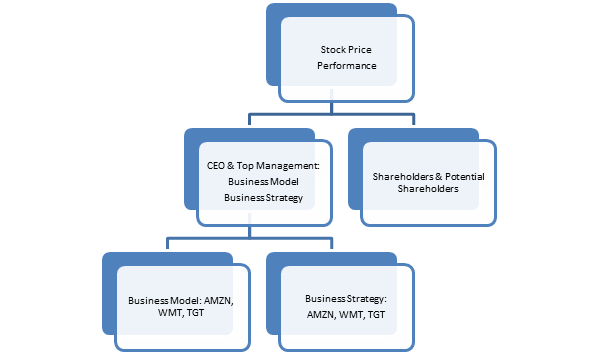Chapter 4: Interpreting Business Ratios:
Case Studies
In
the last chapter you learned how to construct business ratios
and conduct activity analysis.
In this chapter we show you how to use the ratios in real
world situations. We
first use them to analyze the performance of Amazon.com over
time. Then, we use
them for a comparative analysis of Wal-Mart and Target.
In each case, you will see how the interpretation depends
on the company’s business model and strategy.

4.1 Amazon.com Stock Price
History
To appreciate the importance of financial statements in
understanding performance, consider the stock price history of
Amazon.com.

The stock price was $2.40 on July 1, 1997, rose to $86.03 on
April 1, 1999, and was at $89.06 in November of 1999, but then
started to fall. In
January 2000, it was $64.56.
On February 1, 2001, it was at $10.19 and fell further to
$5.97 by September of 2001.
Then started a slow and fairly steady increase through
2008, and was followed by very strong gains though June 2011.
On June 1, 2011, the stock price was $191.63.
Amazon’s performance in the first decade of the 21st
century has been impressive, especially considering that the
stock market (as measured by the S&P 500 Index) lost 7.67%
between January 2000 and June 2011.
The price history also shows that Amazon lost over 90% of
its shareholder value in 2000-2001and then recovered very
strongly.
So what happened?
We will analyze Amazon’s performance in two ways.
First, we will look at the business ratios over time.
Then, we will look at how Amazon changed its business
strategy and how this was reflected in both the ratios and the
stock price.
As background, we will refer to an article in a Fortune Magazine
dated December 18, 2000 by Katrina Brooker. The article
describes Amazon’s focus on growth (“GBF or “Get Big Fast”) and
an obsession with customer satisfaction.
It will be useful to keep this in mind as we take you
through the analysis.
A much more detailed account of the early history of
Amazon.com is in the book “Amazon.Com: Get Big Fast” by Robert
Spector (April 2000).
It contains fascinating details about the growth of the
company and the evolution of its strategy over time,
particularly at the end of the 1990’s.
